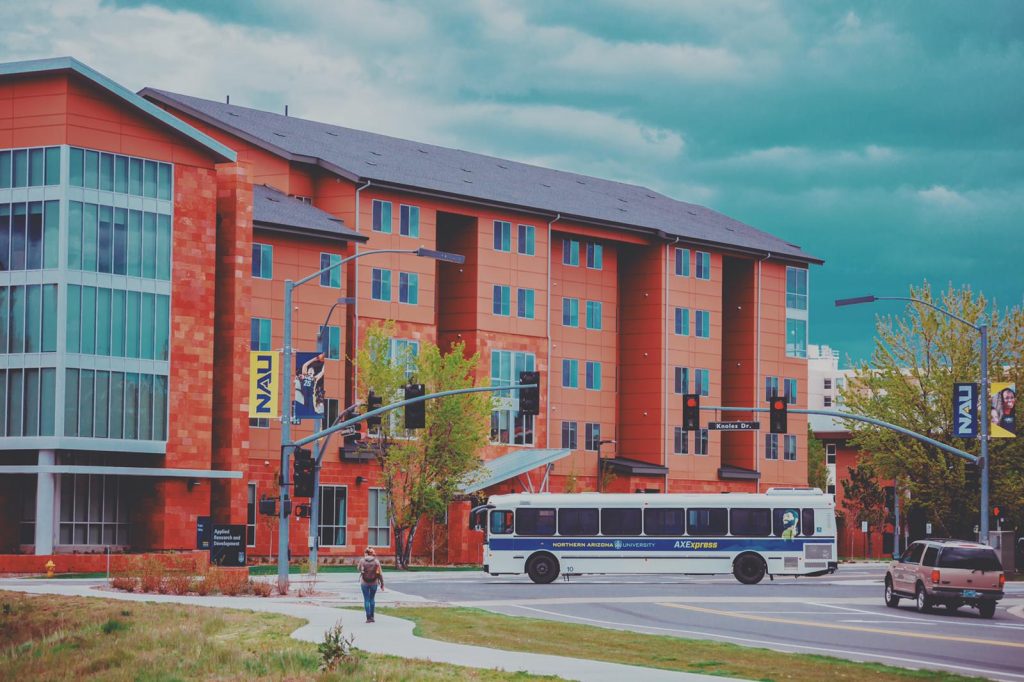Aug. 23, 2019
As campus comes alive with the start of the new semester, more than 12,000 Northern Arizona University students on the Flagstaff campus will ride the bus every day, relying on the university bus system to get them where they need to go in a timely manner.
To meet these needs, University Transit Services runs a number of buses on two routes that circle the campus in opposite directions. Each route had seven buses during peak hours, 7 a.m. to 4 p.m. on weekdays.
In a perfect world, seven buses on each 28-minute route should provide headways of about four minutes. But variability in traffic and weather mixed with surges in ridership created severe bunching with two or three buses traveling together—the transit team’s nightmare.
Knowing so many Lumberjacks depend on reliable bus service, NAU looked into ways to improve the transit experience for passengers, drivers and managers. The university found a system that eliminates bunching, guarantees buses consistently arrive at stops every few minutes, keeps drivers focused on safety and students happy knowing they won’t have long delays that could make them late to class.
That system is BusGenius, created and developed by professors John J. Bartholdi III and Donald D. Eisenstein. BusGenius is a cloud service that ensures buses arrive at regular intervals without running on a predetermined schedule. This means a more efficient transit experience for passengers and less waste paying for buses that aren’t full.
“Before BusGenius, buses bunched up all the time—the trailing buses ran mostly empty, basically making them pointless,” said Judy Lynne Manor, assistant director of Parking and Shuttle Services. “Now, fewer buses provide better headways and save us money. When the buses are evenly spaced, the passenger load is spread more smoothly across all the buses. It’s a win-win!”
The system works like this: After designating a few layover points on a route where a bus might pause briefly, a powerful AI engine in BusGenius monitors the buses, as well as travel and stop times. When a bus arrives at a layover point, the AI engine computes the ideal, short delay required to more evenly space in time all the buses on the route. The wait time is transmitted to the bus, where it is displayed as a countdown on a tablet so driver and passengers can see the bus will depart in, say, one minute 14 seconds. By this means, buses are constantly re-positioned so they arrive at regular intervals—and this requires no oversight by managers or intention by drivers.
Working with teams from Ride Systems, a GPS tracking company, and BusGenius, NAU applied the service to two existing bus routes and added an additional route. NAU staff decided which bus stops would be layover points and set limits on how long a bus was allowed to pause at each of these points. To best serve students, buses were allowed to pause longer at important transit points, such as the main commuter parking lot or the Student Union.
The results of BusGenius have been positive all around.
Because the service runs more efficiently, NAU lessened the number of buses on each of the campus routes from seven to six during the peak hours of 7 a.m. to 4 p.m. on weekdays. By reducing the number of buses on the two main routes, NAU saved 18 bus-hours of service per day; this amounts to a savings of about $1,200 per day, of which at least $500 per day was immediately realizable by reducing the number of driver-hours.
The benefits don’t stop there. Even with fewer buses running, headways now reliably range between 3.5 and 5 minutes—an improvement to the previous headways that could regularly reach 10 to 12 minutes. Frequent buses without a predetermined schedule offer less stress and more flexibility for students; no matter when they get to a bus stop, they can be sure a bus will meet them within a few minutes.
BusGenius also assists managers in dealing with many of those unexpected elements that can cause regular bus routes to bunch. The number of buses can be easily adjusted to match levels of traffic and ridership. For example, if there is a special event and headways are longer than usual, another bus can be added to the route and BusGenius will quickly space all the buses to accommodate the new arrival. Similarly, buses can pass each other if one makes a longer stop, such as when picking up a rider in a wheelchair. BusGenius will recognize this and adjust accordingly.
The campus buses have a huge responsibility to the NAU community. Rain, shine, sleet or snow (and the Flagstaff campus does get them all), Lumberjacks look for their buses to get them all where they need to be when they need to be there. With the innovation of the BusGenius system on NAU routes, the ride is a lot smoother.



